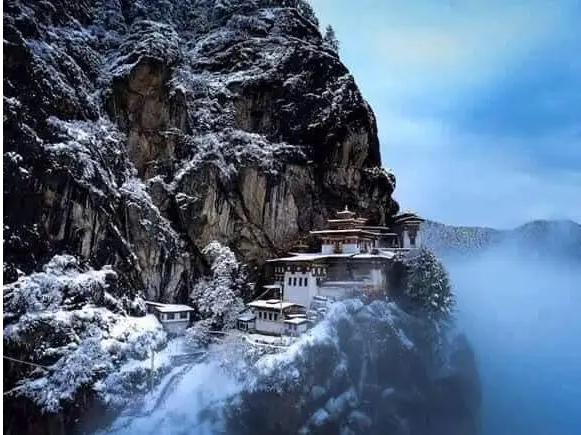Perched dramatically on a sheer cliff at 3,120 meters above sea level, Tiger’s Nest Monastery (Paro Taktsang) is Bhutan’s most sacred and iconic site. Built in 1692, it commemorates Guru Padmasambhava, who introduced Buddhism to Bhutan and meditated here for three years, three months, three weeks, and three days. Legend holds that he arrived on a flying tigress to subdue a local demon, giving the monastery its evocative name. Today, it remains a vital pilgrimage site for Bhutanese Buddhists and a bucket-list destination for global travelers.
Highlights
- Stunning Location: Clinging to a cliffside, the monastery offers breathtaking views of the Paro Valley.
- Sacred Legend: Named for Guru Padmasambhava’s mythical arrival on a tigress, it exudes spiritual mystique.
- Scenic Trek: The 4–5-hour round-trip hike winds through pine forests, vibrant prayer flags, and photogenic viewpoints.
- Cultural Depth: Inside, explore shrines, golden statues, and sacred relics (photography inside is prohibited).
- Serene Ambiance: Fluttering prayer flags, incense, and distant monk chants create a meditative atmosphere.
- Rest Stop: A halfway cafeteria offers tea and stunning monastery views.
- Pilgrimage Significance: Visiting is a profound blessing for Bhutanese Buddhists.
- Seasonal Charm: Spring blooms with rhododendrons, autumn boasts clear skies, and winter dusts peaks with snow.
Packing List
To ensure a comfortable hike to Tiger’s Nest at high altitude:
- Hiking Shoes: Sturdy with good grip for uneven trails.
- Layered Clothing: Lightweight jacket or fleece for chilly mornings; rain jacket for monsoon season (June–August).
- Water Bottle: Reusable for hydration during the climb.
- Sun Protection: Sunglasses, sunscreen, and a hat for intense high-altitude sun.
- Snacks: Energy bars for sustained energy.
- Camera/Smartphone: To capture exterior views (no photography inside).
- Small Backpack: For carrying essentials.
Travel Tips
- Start Early: Begin morning hikes to avoid heat and crowds.
- Acclimatize: Spend a day in Paro to adjust to the altitude.
- Pace Yourself: The 4–5-hour trek includes rest breaks.
- Dress Modestly: Cover shoulders and knees for monastery entry.
- Respect Rules: No photography inside; maintain quiet reverence.
- Support Options: Rent walking sticks or ponies at the trailhead.
- Stay Mindful: Honor the site’s sacred nature with respect.
The best time to visit Tiger’s Nest Monastery is spring (March–May) and autumn (September–November)
- Spring (March–May) – Pleasant temperatures, clear skies, and blooming rhododendrons make the hike colorful and comfortable.
- Autumn (September–November) – Crisp air, excellent visibility of the Himalayas, and dry trails perfect for trekking.
- Winter (December–February) is also beautiful with fewer crowds and some snow, but mornings can be very cold.
- Monsoon (June–August) brings lush greenery but also slippery trails and limited visibility due to rain and clouds.
ODEA Services and Tiger’s Nest
ODEA Services, a trusted Kathmandu-based tour operator, enhances your Tiger’s Nest experience through their Bhutan travel packages, such as the 10-day Nepal and Bhutan Tour. Their services include:
- Expert Guides: Knowledgeable, English-speaking guides share the monastery’s history and cultural significance.
- Seamless Logistics: They arrange permits, transportation to the trailhead, and early starts to optimize your visit.
- Tailored Itineraries: Customize your trip to include Tiger’s Nest alongside other Bhutanese highlights like Thimphu or Punakha.
- Comfort and Safety: ODEA ensures reliable support, from acclimatization advice to coordinating rest stops, with 24/7 customer service.
Conclusion
Visiting Tiger’s Nest Monastery is a transformative journey blending adventure, spirituality, and Himalayan beauty. The trek’s stunning vistas, prayer flags, and serene ambiance leave lasting memories. With ODEA Services’ expert planning and support, your pilgrimage to this sacred Bhutanese landmark will be seamless, enriching, and unforgettable.

